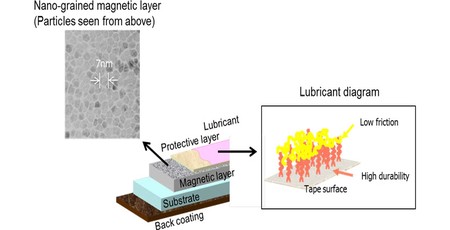Sony, IBM announce 330TB magnetic tape storage breakthrough
August 3, 2017 | 10:55
Companies: #ibm #ibm-research #sony

Sony and IBM have jointly announced a twenty-fold increase in the areal density of magnetic tape storage, producing a cassette capable of holding 330TB of data.
In the early days of computing, paper tape soon gave way to magnetic tape as the primary storage medium for the room-sized systems - to the point where science fiction films weren't complete if there wasn't at least one wardrobe-sized cabinet with a spinning reel-to-reel tape visible in every shot. As the size of tapes grew smaller, they made their way into the realm of home computer - those who grew up in the era of Sinclair ZX80s and Commodore VIC-20s will remember all too well the five- to twenty-minute wait to load a game from a C20 computer cassette - before the cost of floppy disks, boasting higher capacity, throughput, reliability, and random access capabilities, effectively put paid to the medium.
Everywhere, that is, except for the purposes of backup and archiving. Here, there are two key considerations: The medium must be high capacity, and it must be resilient. Even today, tape rules the roost as an archival storage format, and the work of Sony and IBM means that it's unlikely to be replaced any time soon.
Announced late last night during the 28th Magnetic Recording Conference in Tsukuba, Japan, Sony and IBM Research have jointly developed a tape storage system boasting an areal density of 201Gb/in² - some twenty times higher than existing systems. The result is an increase in storage capacity from around 15TB (uncompressed) of data per tape cassette to 330TB - perfect, the companies claim, for bulk storage of data for the Internet of Things (IoT), cloud service providers, and big data analysts.
The trick works thanks to two main breakthroughs: IBM's part is in providing the read-write heads, more advanced servo control technologies, and signal-processing algorithms capable of tracking the finely spaced data on the tape; Sony's contribution, meanwhile, is in the magnetic tape itself, which features a lubricant applied between the tape surface and the read-write head to reduce friction. Coupled with a new nano-grained magnetic layer production process dropping the average grain size to 7nm, the system allows for cartridges holding over a kilometre of tape.
Sony has confirmed that it is to commercialise the technology but has not yet offered a release date for storage systems built around the new tape format.

MSI MPG Velox 100R Chassis Review
October 14 2021 | 15:04








Want to comment? Please log in.